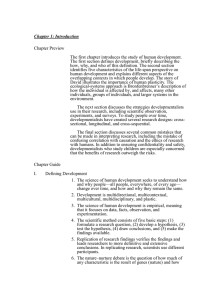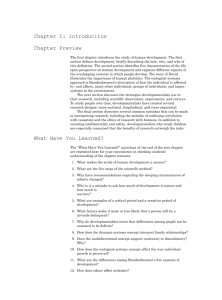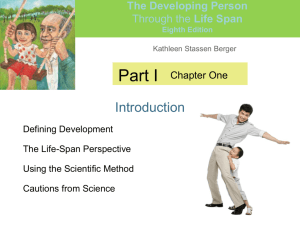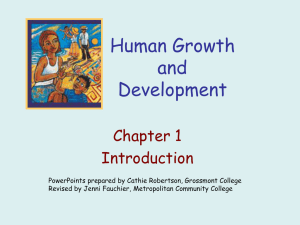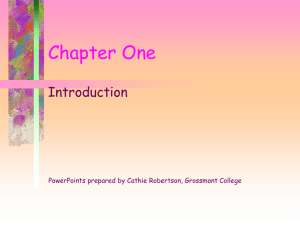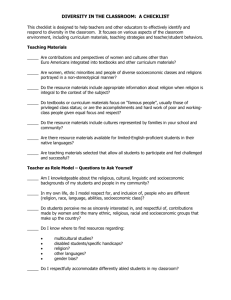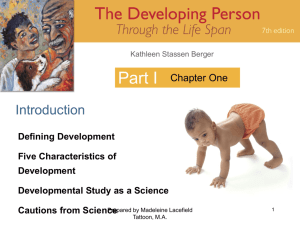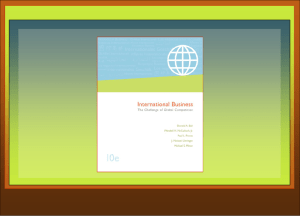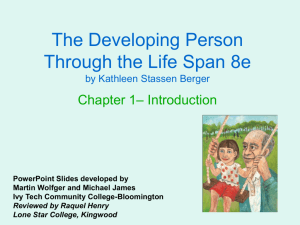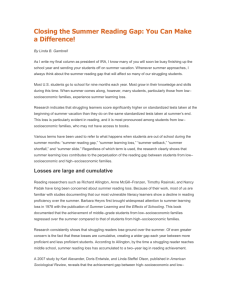Invitation to the Life Span by Kathleen Stassen
advertisement
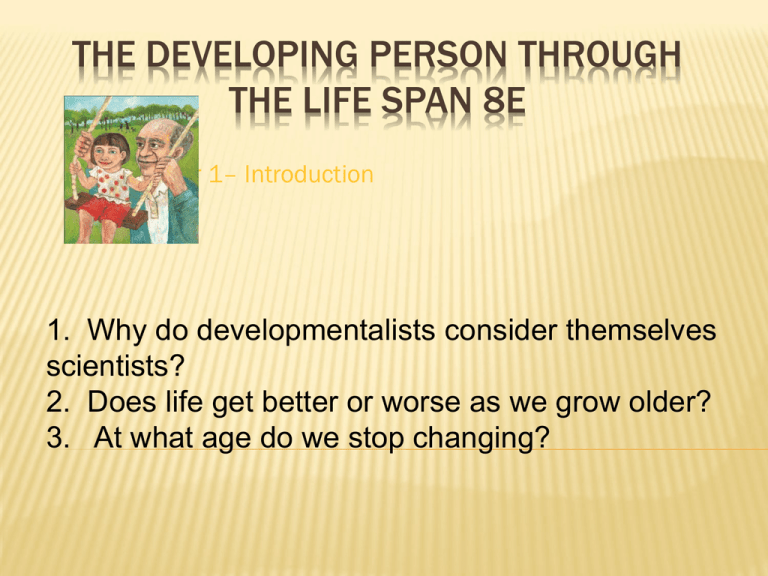
THE DEVELOPING PERSON THROUGH THE LIFE SPAN 8E Chapter 1– Introduction 1. Why do developmentalists consider themselves scientists? 2. Does life get better or worse as we grow older? 3. At what age do we stop changing? 7 STAGES OF DEVELOPMENT 1. Infancy 2. Early Childhood 3. Middle Childhood 4. Adolescence 5. Emerging Adulthood 6. Adulthood 7. Late Adulthood DEFINING DEVELOPMENT The science of human development… seeks to understand how and why people— all kinds of people, everywhere, of every age—change over time. 1. SCIENCE developmental study is a science…. theories data analysis critical thinking sound methodology Understand the “how” and “why” 4 2. DIVERSITY studying all kinds of people young and old rich and poor every ethnicity, background sexual orientation What is universal? What is unique? 5 3. CONNECTIONS BETWEEN CHANGE AND TIME Changing or remaining the same over time transformations consistencies beginning of human life to end understanding each segment of life Each stage is better understood by remembering the whole life, and, conversely, the whole life is understood best by knowing each segment. 6 Understanding How and Why Five Basic Steps of the Scientific Method • Begin with curiosity. • Develop a hypothesis. • Test the hypothesis. • Draw conclusions. • Report the results. THE SCIENTIFIC METHOD Often, a sixth step is needed before the scientific community accepts conclusions. Replication: THE NATURE-NURTURE DEBATE Nature Nurture health and diet of the embryo’s mother family school community society Can we really ask, “How Much?” CRITICAL AND SENSITIVE PERIODS A critical period is a time when certain things ________________ for normal development. A sensitive period is when a particular development occurs __________________. OBSERVING CHANGES OVER TIME Dynamic-Systems Theory A view of human development as an ongoing, ever-changing interaction between the physical and emotional being and between the person and every aspect of his or her environment, including the family and society. THE LIFE-SPAN PERSPECTIVE “…developmentalists are acutely aware of the reciprocal connections between one moment in life and another… leading to five principles that are useful for understanding any age of human life…” 12 MULTIDIRECTIONAL (1) Change you occurs in every direction are affected by many forces! physical health, intellectual growth, and social interaction up, down, stable or erratic MULTICONTEXTUAL (2) “…humans develop in dozens of contexts that profoundly affect their development…” physical surroundings family patterns Urie Bronfenbrenner Social context historical socioeconomic 14 MULTICONTEXTUAL (2) Ecological-Systems Approach (Urie Bronfenbrenner) a leader in understanding ecological systems approach he believed that we need to examine all systems surrounding the development of each person microsysems exosystems macrosystems ECOLOGICAL-SYSTEMS APPROACH microsysems exosystems a person’s immediate surroundings local institutions, such as schools and churches macrosystems larger social setting, including cultural values, economic polices, and political processes 16 THE HISTORICAL CONTEXT cohort people born within a few years of one another these people are affected by the same values events technologies culture 17 THE SOCIOECONOMIC CONTEXT Socioeconomic includes socioeconomic status (ses), MULTICULTURAL (3) Culture— set of values, assumptions, and customs as well as physical objects such as clothing, housing, etc. includes all decisions people make is dynamic, supportive ETHNICITY, RACE, AND CULTURE ethnic groups share certain attributes ancestral heritage (customs and traditions) national origin (country of birth) religion culture language ethnic categories arise from history, sociology, and psychology, not from biology 20 ETHNICITY, RACE, AND CULTURE Race a distorted concept, no clearcut racial groups (1970’s census: white/black/other) -What racial categories have been added? For your racial profile report? Well, sir, my mother was part Panamanian, part Jamaican. My dad was part Ukrainian, part Puerto Rican. I hope that helps. MULTIDISCIPLINARY (4) “…a broad array of disciplines and cross-cutting topics… each person develops simultaneously in body, mind, and spirit…” Development is divided into three domains; Biosocial – Cognitive – Psychosocial – 22 PLASTICITY (5) The possibility to change: human traits can be molded yet maintaining durability of identity culture and upbringing affect both aspects of plasticity Genes and other biological influences provides hope and realism hope = changes is possible realism = each developing person must build on what has come before 23 THE LIFE-SPAN PERSPECTIVE Mirror neuronsCells in an observer’s brain that respond to an action performed by someone else in the same way they would if the observer had actually performed it. “We need to keep in mind that the future is not something we simply enter, the future is also something we help create.” Paul Baltes (Founder of lifespan developmental study)
